Book Description
Natural Fiber-Reinforced Biodegradable and Bioresorbable Polymer Composites focuses on key areas of fundamental research and applications of biocomposites. Several key elements that affect the usage of these composites in real-life applications are discussed. There will be a comprehensive review on the different kinds of biocomposites at the beginning of the book, then the different types of natural fibers, bio-polymers, and green nanoparticle biocomposites are discussed as well as their potential for future development and use in engineering biomedical and domestic products.
Recently mankind has realized that unless the environment is protected, he himself will be threatened by the over consumption of natural resources as well as a substantial reduction in the amount of fresh air produced in the world. Conservation of forests and the optimal utilization of agricultural and other renewable resources like solar, wind, and tidal energy, have become important topics worldwide. With such concern, the use of renewable resources—such as plant and animal-based, fiber-reinforced polymeric composites—are now becoming an important design criterion for designing and manufacturing components for a broad range of different industrial products.
Research on biodegradable polymeric composites can contribute, to some extent, to a much greener and safer environment. For example, in the biomedical and bioengineering fields, the use of natural fiber mixed with biodegradable and bioresorbable polymers can produce joint and bone fixtures to alleviate pain in patients.
- Includes comprehensive information about the sources, properties, and biodegradability of natural fibers
- Discusses failure mechanisms and modeling of natural fibers composites
- Analyzes the effectiveness of using natural materials for enhancing mechanical, thermal, and biodegradable properties
